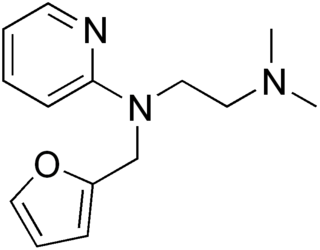Methaphenilene is an antihistamine and anticholinergic.
Contents
 | |
| Identifiers | |
|---|---|
| |
| CAS Number | |
| ChemSpider | |
| UNII | |
| CompTox Dashboard (EPA) | |
| ECHA InfoCard | 100.007.074 |
| Chemical and physical data | |
| Formula | C15H20N2S |
| Molar mass | 260.40 g·mol−1 |
| 3D model (JSmol) | |
| |
| |
Methaphenilene is an antihistamine and anticholinergic.
 | |
| Identifiers | |
|---|---|
| |
| CAS Number | |
| ChemSpider | |
| UNII | |
| CompTox Dashboard (EPA) | |
| ECHA InfoCard | 100.007.074 |
| Chemical and physical data | |
| Formula | C15H20N2S |
| Molar mass | 260.40 g·mol−1 |
| 3D model (JSmol) | |
| |
| |
Methaphenilene can be synthesized from N,N-dimethyl-N′-phenylethane-1,2-diamine by alkylation with 2-(chloromethyl)thiophene. [1]


Histamine is an organic nitrogenous compound involved in local immune responses communication, as well as regulating physiological functions in the gut and acting as a neurotransmitter for the brain, spinal cord, and uterus. Since histamine was discovered in 1910, it has been considered a local hormone (autocoid) because it lacks the classic endocrine glands to secrete it; however, in recent years, histamine has been recognized as a central neurotransmitter. Histamine is involved in the inflammatory response and has a central role as a mediator of itching. As part of an immune response to foreign pathogens, histamine is produced by basophils and by mast cells found in nearby connective tissues. Histamine increases the permeability of the capillaries to white blood cells and some proteins, to allow them to engage pathogens in the infected tissues. It consists of an imidazole ring attached to an ethylamine chain; under physiological conditions, the amino group of the side-chain is protonated.
H1 antagonists, also called H1 blockers, are a class of medications that block the action of histamine at the H1 receptor, helping to relieve allergic reactions. Agents where the main therapeutic effect is mediated by negative modulation of histamine receptors are termed antihistamines; other agents may have antihistaminergic action but are not true antihistamines.

Chlorphenamine, also known as chlorpheniramine, is an antihistamine used to treat the symptoms of allergic conditions such as allergic rhinitis. It is taken orally. The medication takes effect within two hours and lasts for about 4-6 hours.

Cetirizine is a second-generation antihistamine used to treat allergic rhinitis, dermatitis, and urticaria (hives). It is taken by mouth. Effects generally begin within thirty minutes and last for about a day. The degree of benefit is similar to other antihistamines such as diphenhydramine, which is a first-generation antihistamine.

Doxylamine, sold under the brand name Unisom among others, is an antihistamine medication which is used in the treatment of insomnia and allergies. It is also used to treat morning sickness in pregnant women in combination with pyridoxine (vitamin B6). Doxylamine is available over-the-counter, and is used in nighttime cold medicines, such as NyQuil, as well as in pain medications containing acetaminophen and codeine, to help with sleep. The medication is taken by mouth.

Ketotifen is an antihistamine medication and a mast cell stabilizer commonly used to treat allergic conditions such as conjunctivitis, asthma, and urticaria (hives). Ketotifen is available in ophthalmic and oral forms: the ophthalmic form relieves eye itchiness and irritation associated with seasonal allergies, while the oral form helps prevent systemic conditions such as asthma attacks and allergic reactions. In addition to treating allergies, ketotifen has shown efficacy in managing systemic mast cell diseases such as mastocytosis and mast cell activation syndrome (MCAS), which involve abnormal accumulation or activation of mast cells throughout the body. Ketotifen is also used for other allergic-type conditions like atopic dermatitis (eczema) and food allergies.

The H1 receptor is a histamine receptor belonging to the family of rhodopsin-like G-protein-coupled receptors. This receptor is activated by the biogenic amine histamine. It is expressed in smooth muscles, on vascular endothelial cells, in the heart, and in the central nervous system. The H1 receptor is linked to an intracellular G-protein (Gq) that activates phospholipase C and the inositol triphosphate (IP3) signalling pathway. Antihistamines, which act on this receptor, are used as anti-allergy drugs. The crystal structure of the receptor has been determined (shown on the right/below) and used to discover new histamine H1 receptor ligands in structure-based virtual screening studies.

Dexbrompheniramine is an antihistamine with anticholinergic properties used to treat allergic conditions such as hay fever or urticaria. It is the pharmacologically active dextrorotatory isomer of brompheniramine. It was formerly marketed in combination with pseudoephedrine under the name Drixoral in the US and Canada. It is an alkylamine antihistamine.
A diamine is an amine with exactly two amino groups. Diamines are used as monomers to prepare polyamides, polyimides, and polyureas. The term diamine refers mostly to primary diamines, as those are the most reactive.

Diphenylpyraline is a first-generation antihistamine with anticholinergic effects of the diphenylpiperidine class. It is marketed in Europe for the treatment of allergies. DPP has also been found to act as a dopamine reuptake inhibitor and produces hyperactivity in rodents. It has been shown to be useful in the treatment of Parkinsonism.

Methdilazine is a first-generation antihistamine with anticholinergic properties of the phenothiazine class.

Mepyramine, also known as pyrilamine, is a first generation antihistamine, targeting the H1 receptor as an inverse agonist. Mepyramine rapidly permeates the brain, often causing drowsiness. It is often sold as a maleate salt, pyrilamine maleate.

Diamine oxidase (DAO), also known "amine oxidase, copper-containing, 1" (AOC1), formerly called histaminase, is an enzyme involved in the metabolism, oxidation, and inactivation of histamine and other polyamines such as putrescine or spermidine. The enzyme belongs to the amine oxidase (copper-containing) (AOC) family of amine oxidase enzymes.

Chlorphenoxamine (Phenoxene) is an antihistamine and anticholinergic used as an antipruritic and antiparkinsonian agent. It is an analog of diphenhydramine.

Cloperastine (INN) or cloperastin, in the forms of cloperastine hydrochloride (JAN) and cloperastine fendizoate, is an antitussive and antihistamine that is marketed as a cough suppressant in Japan, Hong Kong, and in some European countries. It was first introduced in 1972 in Japan, and then in Italy in 1981.

Antihistamines are drugs which treat allergic rhinitis, common cold, influenza, and other allergies. Typically, people take antihistamines as an inexpensive, generic drug that can be bought without a prescription and provides relief from nasal congestion, sneezing, or hives caused by pollen, dust mites, or animal allergy with few side effects. Antihistamines are usually for short-term treatment. Chronic allergies increase the risk of health problems which antihistamines might not treat, including asthma, sinusitis, and lower respiratory tract infection. Consultation of a medical professional is recommended for those who intend to take antihistamines for longer-term use.

Methafurylene is an antihistamine and anticholinergic.

1,2-Diaminopropane (propane-1,2-diamine) is organic compound with the formula CH3CH(NH2)CH2NH2. A colorless liquid, it is the simplest chiral diamine. It is used as a bidentate ligand in coordination chemistry.

Quifenadine is a 2nd generation antihistamine drug, marketed mainly in post-Soviet countries. Chemically, it is a quinuclidine derivative.

Phenbenzamine, sold under the brand name Antergan and known by the former developmental code name RP-2339, is an antihistamine of the ethylenediamine class which also has anticholinergic properties. It was introduced in 1941 or 1942 and was the first antihistamine to be introduced for medical use. Soon following its introduction, phenbenzamine was replaced by another antihistamine of the same class known as mepyramine. Following this, other antihistamines, such as diphenhydramine, promethazine, and tripelennamine, were developed and introduced. Owing to their sedative effects, phenbenzamine and promethazine were assessed in the treatment of manic depression in France in the 1940s and were regarded as promising therapies for such purposes. Whereas phenbenzamine was the first clinically useful antihistamine, piperoxan was the first compound with antihistamine properties to be discovered and was synthesized in the early 1930s.